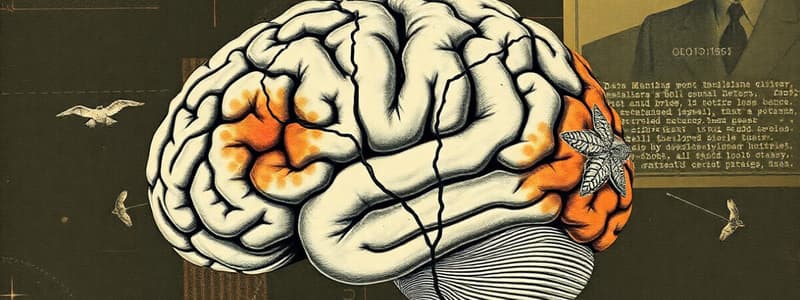Podcast
Questions and Answers
What is the primary function of the limbic system?
What is the primary function of the limbic system?
- Sense of smell (correct)
- Taste sensation
- Sight perception
- Fighting instinct
Which brain component is responsible for long-term memory?
Which brain component is responsible for long-term memory?
- Hippocampus (correct)
- Cerebellum
- Brainstem
- Thalamus
The thalamus is part of the limbic system.
The thalamus is part of the limbic system.
False (B)
What does EEG stand for?
What does EEG stand for?
The _____ is responsible for controlling the body's endocrine functions.
The _____ is responsible for controlling the body's endocrine functions.
Which component is NOT part of the Central Nervous System?
Which component is NOT part of the Central Nervous System?
What is the function of an fMRI scan?
What is the function of an fMRI scan?
A PET scan detects a radioactive form of _____ while the brain performs tasks.
A PET scan detects a radioactive form of _____ while the brain performs tasks.
The corpus callosum connects the two hemispheres of the brain.
The corpus callosum connects the two hemispheres of the brain.
What does MRI stand for?
What does MRI stand for?
Which hemisphere of the brain is associated with logical tasks?
Which hemisphere of the brain is associated with logical tasks?
The right hemisphere of the brain is involved in processing:
The right hemisphere of the brain is involved in processing:
Flashcards are hidden until you start studying
Study Notes
The Limbic System
- Responsible for sense of smell, libido, and long-term memory
- Comprises the thalamus, hypothalamus, hippocampus, pituitary gland, brainstem, spinal cord, cerebellum, corpus callosum, and cerebral cortex
The Divided Brain
- Different parts of the brain control different functions
- fMRI combines MRI and PET to map brain activity
The Nervous System
- Central Nervous System includes the brain and spinal cord
- Peripheral Nervous System includes the ganglion and nerve
Central Nervous System
- The brain and spinal cord act as the central processing unit of the body
Techniques for Studying the Brain
- Various techniques are used to study the brain
- Brain damage can reveal valuable information about brain function
Lesioning
- Removal or destruction of part of the brain can show changes in behavior and infer the function of that brain region
Functional Methods
EEG
- It records electrical waves sweeping across the brain's surface
- Sleep studies use EEG to monitor brain activity
PET Scan
- It shows brain activity by detecting radioactive glucose uptake
- Helps link brain activity to the area of the brain controlling it
Structural Methods
MRI Scan
- Uses magnetic fields and radio waves to produce detailed images of brain tissue
- Different from CAT scans but produces similar images
Combination Method (Structure & Function)
fMRI
- Compares images before and during mental functions to map brain regions involved
- Combines aspects of MRI and PET
- Illustrates brain activity during specific tasks, such as lying
The Cerebrum
- The largest part of the brain
- Includes the four lobes of the brain (frontal, parietal, temporal, occipital), interbrain, and limbic system
Splitting the Brain
- A procedure where the corpus callosum is severed to isolate the two hemispheres
- Typically done to prevent seizures in severe epilepsy patients
Our Divided Brain
- The brain is divided into two hemispheres:
The Left Hemisphere
- Processes logical tasks like reading, writing, speaking, math, and comprehension
- Controls the right side of the body
- Considered the dominant brain
The Right Hemisphere
- Processes non-verbal tasks like spatial relationships, music/artistic ability, and mental imagery
- Controls the left side of the body
- May be associated with certain negative emotions
Central Nervous System
- Acts as the central processing unit, regulating and coordinating all body functions
- Consists of the brain and spinal cord
Brain Anatomy
- Includes the parietal lobe, occipital lobe, cerebellum, spinal cord, temporal lobe, and frontal lobe
Sections of the Brain
- Three major parts: cerebrum, cerebellum, and brainstem
Studying That Suits You
Use AI to generate personalized quizzes and flashcards to suit your learning preferences.




